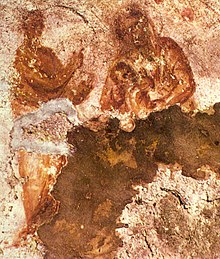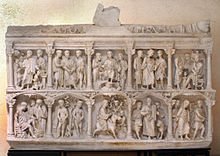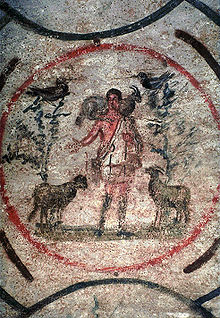Early Christian art

The early Christian or early Christian art covers the period from the creation of the first pictorial evidence of Christians in all the territories of the Roman Empire until the end of antiquity . Just like the early Christians were part of ancient Roman society, their art is also part of Greco-Roman society and uses their imagery to depict specifically Christian themes.
Early Christian art thus formed a small part of art from the imperial era during the first centuries AD , from the 4th century AD onwards it is almost equated with late antique art and goes back to around the 6th century AD. in the east into Byzantine art and in the west into pre-Romanesque .
Before the year 313 , in the Emperor Constantine the Christianity with the Milan Edict declared to equal religion, the Christian art limited to cabaret , reliefs and murals such. B. in the Roman catacombs . After the change in Constantine , thanks to imperial support, it also gained a monumental component, especially through the large church buildings that were now being built, such as B. Old St. Peter in Rome .
From the ban on images to the first artistic representations
The leading Christians of the early Church doubted until the third century that there could be a Christian art which was able to give the spiritual word of revelation visible form. This is how the Christian Octavius responded towards the end of the 2nd century to the reproach of the lack of Christian art:
- “What temple should I build for him when this whole world, the work of his hands, cannot grasp him? ... Is it not better for us to build a sanctuary to him in our souls, rather to consecrate a place in our breasts? "
In the early Christian period, the legacy of Judaism and the requirement of the first commandment “You shall not make yourself an image” had a strong effect. Though Judaism is religious art; for example in the gilded cherubs, door panels decorated in relief and ornate bronze basins of the Temple of Solomon; knows, the plastic image of God and the magical image of a living being is forbidden. Since the creative person works according to his ideas, God's glory and incomprehensibility would automatically be reduced or anthropomorphized .
The image could become an idol , claiming power and worship instead of just being a reference to God. Since the time of the Maccabees , the rejection of any pictorial representation in Judaism became more and more decisive. Since the Christians of the early Church still believed in the imminent return of the Lord in part during their lifetime, art was not one of the important things. In addition, the strong influence of Neoplatonism caused an attitude hostile to art, which took the view that the soul can only come closer to God to the extent that it rises above the senses. Up to the 4th century there was no representation of Jesus either alone or with characteristic features. If it is represented figuratively, then only as an allegorical symbol e.g. B. as a good shepherd or philosopher.
Nevertheless, in the course of time, the ancient joy of painting slowly asserted itself against the initial rejection of artistic representation. The initiative came more from the people than from the church authorities. The earliest and best pictures were therefore not in the catacombs , but in the houses and house churches of rich Christians. The animal representations, which were already popular in the non-Christian and pagan environment, were imported and reinterpreted in Christian symbolism . The dove became the image of the redeemed soul, the peacock remained the pre-Christian symbol of immortality, and the fish became Eucharistic food.
Early Christian church building
Cabaret
With the strengthening of Christianity in late antiquity, corresponding image content can also be found on small monuments. Mostly it is about everyday objects. These include glass vessels with cut or incised decorations and intermediate gold glasses, as well as North African terra sigillata , finger rings, etc. Since Constantine, coins with Christian symbols such as a Christogram have also been minted.
Sculptures
Free plastic
Free sculptural portraits are very rare. Nevertheless, a continuation of the imperial tradition of setting up portrait statues of emperors and deserving citizens in public places can be seen. The so-called Colossus of Barletta is an example of this . Portrait statues or busts may still have been erected in the funeral context. Compared to earlier times, a strong generalization of the portraits can be observed in late antiquity. This makes it extremely difficult to assign individual works to specific people.
Relief sarcophagi

The early Christian sarcophagus sculpture represents one of the most extensive genres within early Christian art. It stands entirely in the tradition of the imperial sarcophagi . While it was still common practice to cremate the deceased in the Republican and early Imperial times, in the early 2nd century AD, inhumation became fashionable in the Roman Empire. Wealthy families now used sarcophagi that were decorated with reliefs. From the 3rd century AD, scenes from the Old and New Testaments appeared on such relief sarcophagi for the first time. The vast majority of the early Christian sarcophagi come from Rome itself. Production continued here until shortly after AD 400. Far fewer examples are known from Ravenna , where production took place from the 5th to the 8th century.
Since the inauguration of Constantinople in 330 AD, sarcophagi have also been made there, albeit only in small numbers. In addition, sarcophagi with Christian themes were created in some provinces. Especially southern Gaul with a focus on Arles should be mentioned here. While marble was practically always used for the more elaborate sarcophagi, simpler pieces were also made from limestone, sandstone or volcanic rock. The hard-to-work porphyry was only used for members of the imperial family .
Symbols, pictures, and biblical narratives
When depicting and describing Christian symbols, images and biblical stories, early Christian art showed a preference for certain motifs and stories. Some motifs are statistically more common. Others are completely absent or are shown more rarely than in later epochs.
The Good Shepherd
The figure of the Good Shepherd or the sheep bearer was the most popular of all rescue images among the Christians of the 3rd century. More than 300 painted or carved shepherds have been preserved. This representation can be found in the baptistery of St. Peter as well as in the portico of the Lateranes baptistery. She can be found four times in the San Giovanni in fonte in Naples .
The motif can draw on many suggestions from the Old and New Testaments. It originally comes from pagan art, where figures that carry young sacrificial animals over their shoulders have been known since archaic times . In the 3rd century AD, depictions of the sheep-bearer, like other pictures with a pastoral theme, enjoyed great popularity in Roman society and were a general symbol of humanitarian concern ( philanthropy ) and the hope of a heavenly life after death. For this period it is therefore often difficult or impossible to determine whether the image of a shaft wearer is a Christian or a pagan work of art.
See also
literature
- Johannes G. Deckers : The early Christian and Byzantine art. Munich 2007.
- Friedrich Wilhelm Deichmann : Introduction to Christian Archeology. Darmstadt 1983.
- André Grabar : The Art of Early Christianity. Munich 1967.
- Wolfgang Kemp : Christian Art. Your beginnings - your structures. Munich 1994.
- Guntram Koch : Early Christian Art. An introduction. Kohlhammer 1995.
- Heinrich Laag : Small dictionary of early Christian art and archeology (Reclam Knowledge Volume 8633). Philipp Reclam jun., Stuttgart 1990, ISBN 3-15-008633-7 .
- Arne Effenberger : Early Christian Art and Culture. From the beginning to the 7th century Munich 1986.
- Wilhelm Neuss : The Art of the Ancient Christians. Augsburg 1926
- David Talbot Rice : The Beginning and Development of Christian Art. Cologne 1961.
Individual evidence
- ^ Apologists, early Christian - M. Minucius Felix, Octavius, XXXII at the University of Friborg, Department for Patristic and Church History
- ↑ a b Horst Robert Balz, Gerhard Krause, Gerhard Müller: Theologische Realenzyklopädie, Volume 3, De Gruyter, 1978, page 401
- ↑ Eduard Syndicius: The Early Christian Art, Paul Pattloch Verlag, Aschaffenburg, 1960, page 5 ff.
- ↑ Johann Peter Balthasar Kreuser, J. Kreuser: The Christian Church Building, Its History, Symbolism, Sculpture and Suggestions for New Buildings, 1861, page 295
- ↑ Eduard Syndicius: The Early Christian Art, Paul Pattloch Verlag, Aschaffenburg, 1960, page 16 et seq.
- ^ Henry Chadwick: The Church in the Ancient World, de Gruyter, 1972, 325


